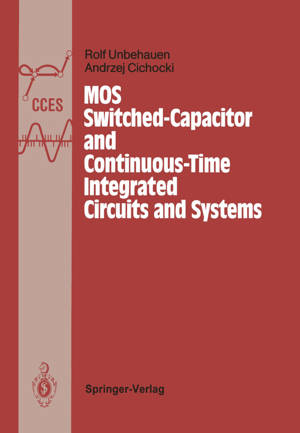
- Afhalen na 1 uur in een winkel met voorraad
- Gratis thuislevering in België vanaf € 30
- Ruim aanbod met 7 miljoen producten
- Afhalen na 1 uur in een winkel met voorraad
- Gratis thuislevering in België vanaf € 30
- Ruim aanbod met 7 miljoen producten
Mos Switched-Capacitor and Continuous-Time Integrated Circuits and Systems
Analysis and Design
Rolf Unbehauen, Andrzej Cichocki
€ 167,95
+ 335 punten
Omschrijving
The purpose of this book is to present analysis and design principles, procedures and techniques of analog integrated circuits which are to be implemented in MOS (metal oxide semiconductor) technology. MOS technology is becoming dominant in the realization of digital systems, and its use for analog circuits opens new pos- sibilities for the design of complex mixed analog/digital VLSI (very large scale in- tegration) chips. Although we are focusing attention in this book principally on circuits and systems which can be implemented in CMOS technology, many con- siderations and structures are of a general nature and can be adapted to other promising and emerging technologies, namely GaAs (Gallium Arsenide) and BI- MOS (bipolar MOS, i. e. circuits which combine both bipolar and CMOS devices) technology. Moreover, some of the structures and circuits described in this book can also be useful without integration. In this book we describe two large classes of analog integrated circuits: - switched capacitor (SC) networks, - continuous-time CMOS (unswitched) circuits. SC networks are sampled-data systems in which electric charges are transferred from one point to another at regular discrete intervals of time and thus the signal samples are stored and processed. Other circuits belonging to this class of sampled-data systems are charge transfer devices (CTD) and charge coupled dev- ices (CCD). In contrast to SC circuits, continuous-time CMOS circuits operate continuously in time. They can be considered as subcircuits or building blocks (e. g.
Specificaties
Betrokkenen
- Auteur(s):
- Uitgeverij:
Inhoud
- Aantal bladzijden:
- 631
- Taal:
- Engels
- Reeks:
Eigenschappen
- Productcode (EAN):
- 9783642836794
- Verschijningsdatum:
- 5/12/2011
- Uitvoering:
- Paperback
- Formaat:
- Trade paperback (VS)
- Afmetingen:
- 170 mm x 244 mm
- Gewicht:
- 1020 g

Alleen bij Standaard Boekhandel
+ 335 punten op je klantenkaart van Standaard Boekhandel
Beoordelingen
We publiceren alleen reviews die voldoen aan de voorwaarden voor reviews. Bekijk onze voorwaarden voor reviews.








